Abstract
Tyrosinase-positive oculocutaneous albinism (ty-pos OCA), an autosomal recessive disorder of the melanin biosynthetic pathway, is the most common type of albinism occurring worldwide. In southern African Bantu-speaking negroids it has an overall prevalence of about 1/3,900. Since the basic biochemical defect is unknown, a linkage study with candidate loci, candidate chromosomal regions, and random loci was undertaken. The ty-pos OCA locus was found to be linked to two arbitrary loci, D15S10 and D15S13, in the Prader-Willi/Angelman chromosomal region on chromosome 15q11.2-q12. The pink-eyed dilute locus, p, on mouse chromosome 7, maps close to a region of homology on human chromosome 15q, and we postulate that the ty-pos OCA and p loci are homologous.
Full text
PDF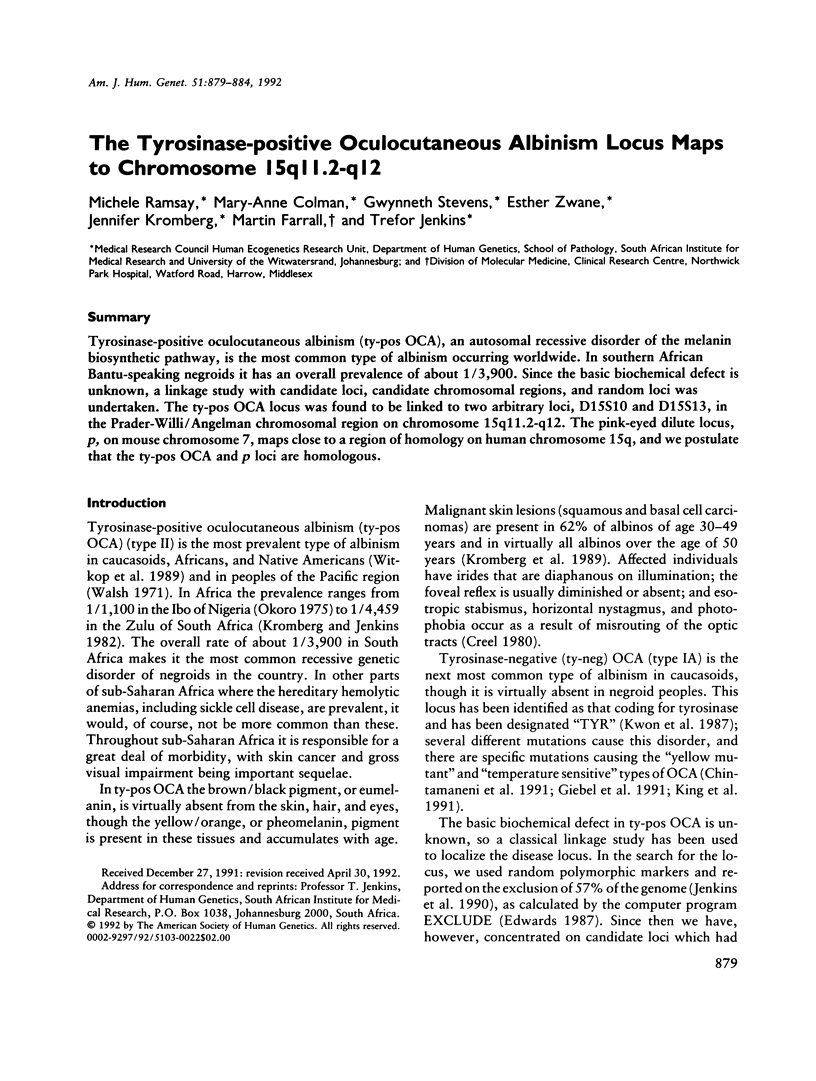

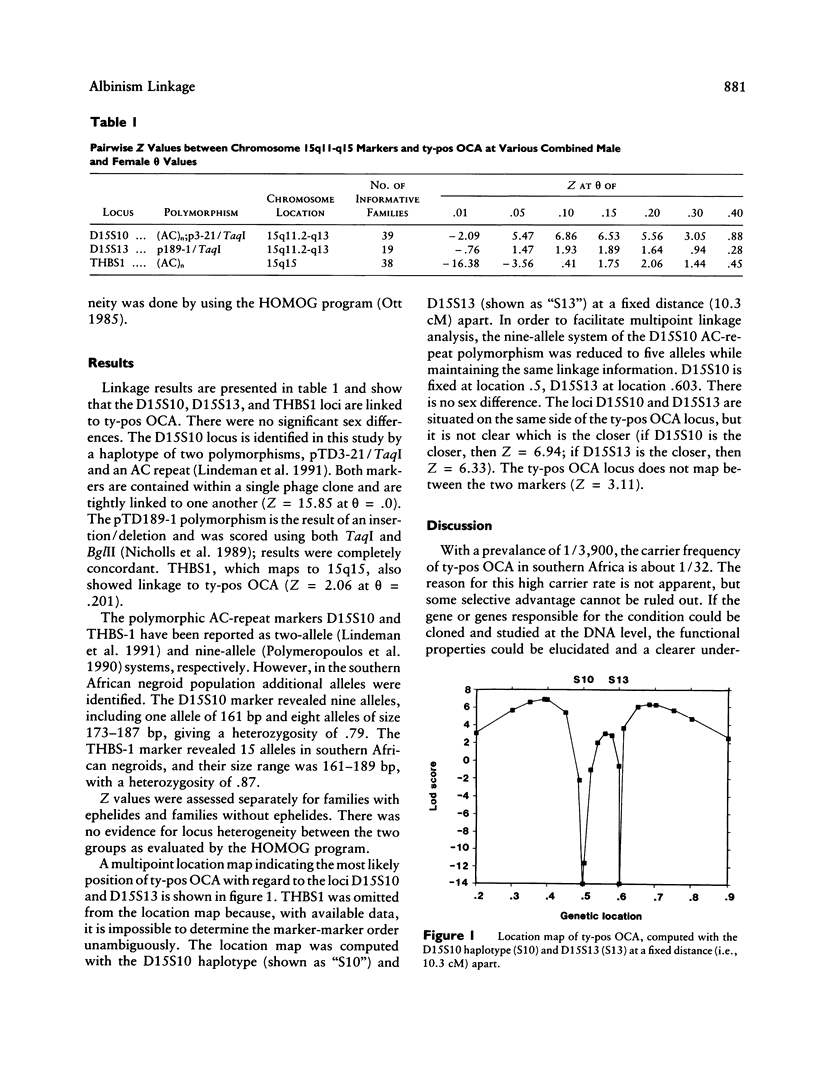
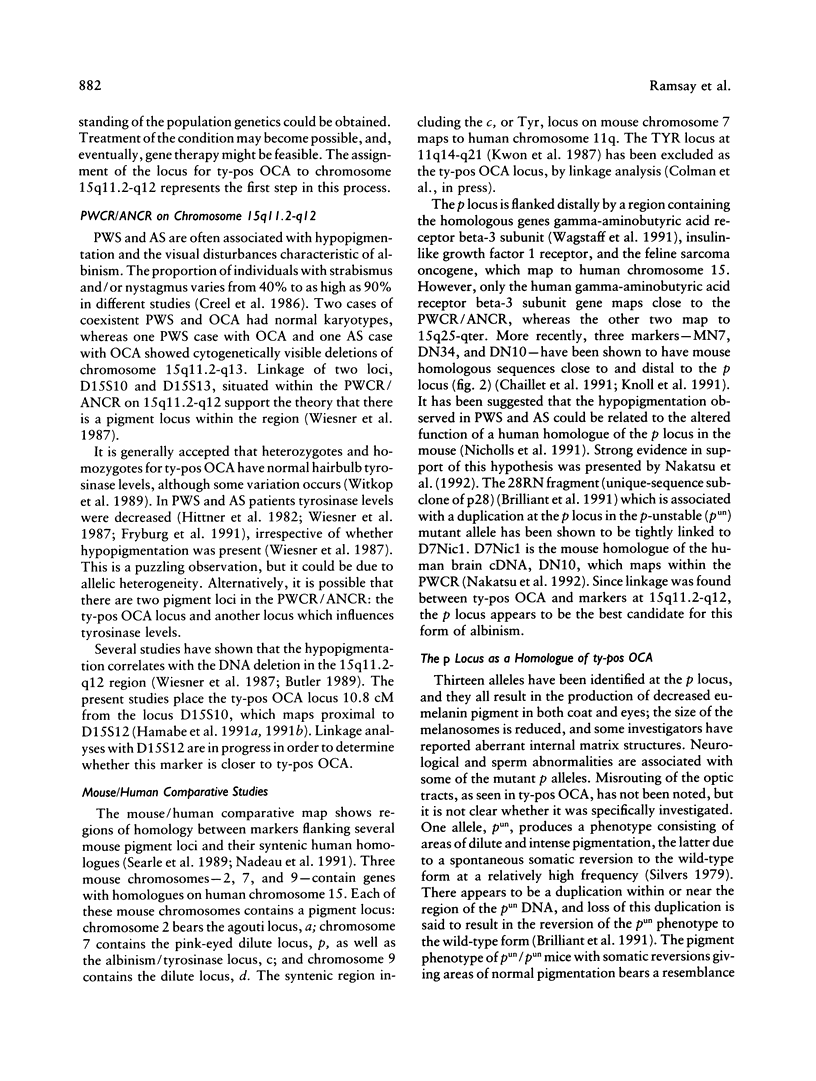
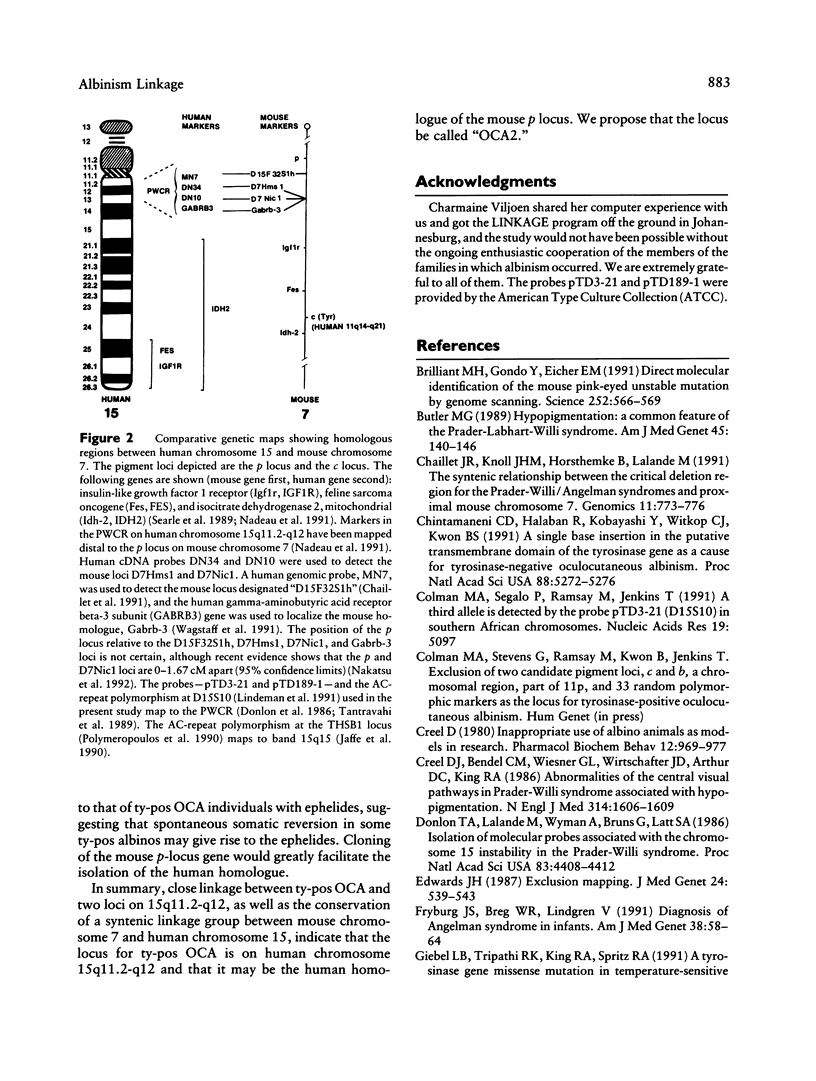
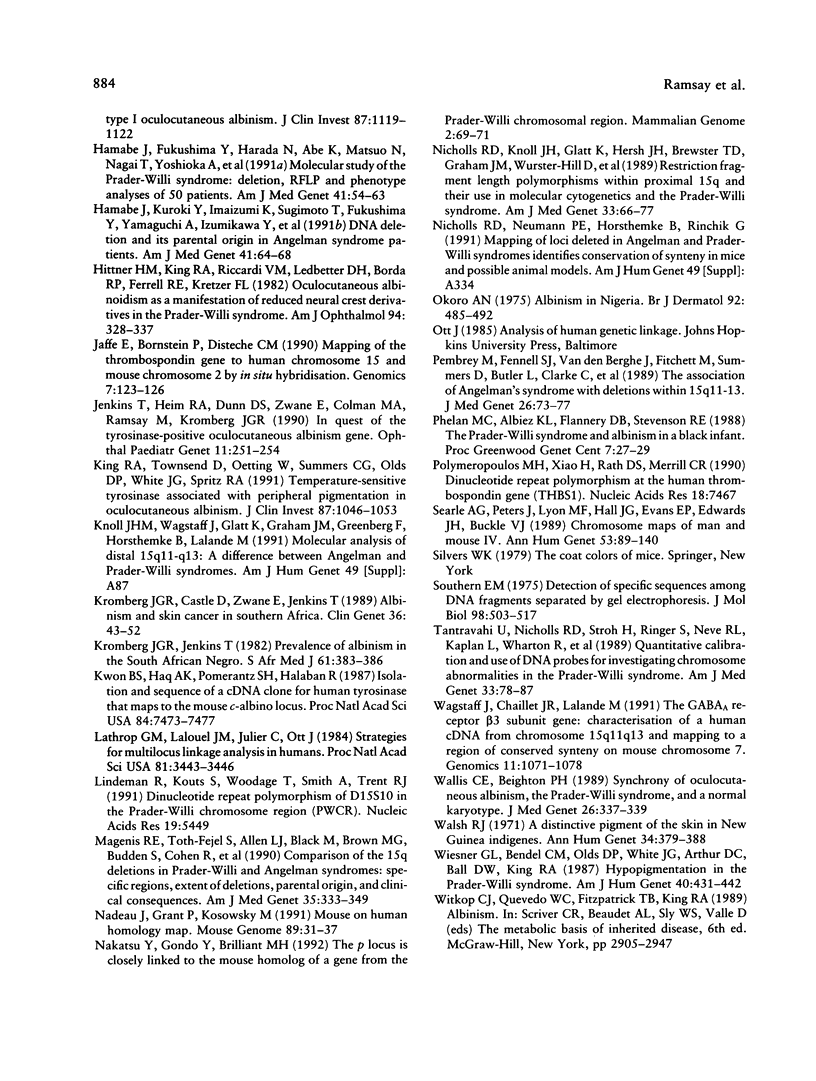
Selected References
These references are in PubMed. This may not be the complete list of references from this article.
- Brilliant M. H., Gondo Y., Eicher E. M. Direct molecular identification of the mouse pink-eyed unstable mutation by genome scanning. Science. 1991 Apr 26;252(5005):566–569. doi: 10.1126/science.1673574. [DOI] [PubMed] [Google Scholar]
- Butler M. G. Hypopigmentation: a common feature of Prader-Labhart-Willi syndrome. Am J Hum Genet. 1989 Jul;45(1):140–146. [PMC free article] [PubMed] [Google Scholar]
- Chaillet J. R., Knoll J. H., Horsthemke B., Lalande M. The syntenic relationship between the critical deletion region for the Prader-Willi/Angelman syndromes and proximal mouse chromosome 7. Genomics. 1991 Nov;11(3):773–776. doi: 10.1016/0888-7543(91)90090-2. [DOI] [PubMed] [Google Scholar]
- Chintamaneni C. D., Halaban R., Kobayashi Y., Witkop C. J., Jr, Kwon B. S. A single base insertion in the putative transmembrane domain of the tyrosinase gene as a cause for tyrosinase-negative oculocutaneous albinism. Proc Natl Acad Sci U S A. 1991 Jun 15;88(12):5272–5276. doi: 10.1073/pnas.88.12.5272. [DOI] [PMC free article] [PubMed] [Google Scholar]
- Colman M. A., Segalo P., Ramsay M., Jenkins T. A third TaqI allele is detected by the probe pTD3-21 (D15S10) in southern African chromosomes. Nucleic Acids Res. 1991 Sep 25;19(18):5097–5097. doi: 10.1093/nar/19.18.5097. [DOI] [PMC free article] [PubMed] [Google Scholar]
- Creel D. J., Bendel C. M., Wiesner G. L., Wirtschafter J. D., Arthur D. C., King R. A. Abnormalities of the central visual pathways in Prader-Willi syndrome associated with hypopigmentation. N Engl J Med. 1986 Jun 19;314(25):1606–1609. doi: 10.1056/NEJM198606193142503. [DOI] [PubMed] [Google Scholar]
- Creel D. Inappropriate use of albino animals as models in research. Pharmacol Biochem Behav. 1980 Jun;12(6):969–967. doi: 10.1016/0091-3057(80)90461-x. [DOI] [PubMed] [Google Scholar]
- Donlon T. A., Lalande M., Wyman A., Bruns G., Latt S. A. Isolation of molecular probes associated with the chromosome 15 instability in the Prader-Willi syndrome. Proc Natl Acad Sci U S A. 1986 Jun;83(12):4408–4412. doi: 10.1073/pnas.83.12.4408. [DOI] [PMC free article] [PubMed] [Google Scholar]
- Edwards J. H. Exclusion mapping. J Med Genet. 1987 Sep;24(9):539–543. doi: 10.1136/jmg.24.9.539. [DOI] [PMC free article] [PubMed] [Google Scholar]
- Fryburg J. S., Breg W. R., Lindgren V. Diagnosis of Angelman syndrome in infants. Am J Med Genet. 1991 Jan;38(1):58–64. doi: 10.1002/ajmg.1320380114. [DOI] [PubMed] [Google Scholar]
- Giebel L. B., Tripathi R. K., King R. A., Spritz R. A. A tyrosinase gene missense mutation in temperature-sensitive type I oculocutaneous albinism. A human homologue to the Siamese cat and the Himalayan mouse. J Clin Invest. 1991 Mar;87(3):1119–1122. doi: 10.1172/JCI115075. [DOI] [PMC free article] [PubMed] [Google Scholar]
- Hamabe J., Fukushima Y., Harada N., Abe K., Matsuo N., Nagai T., Yoshioka A., Tonoki H., Tsukino R., Niikawa N. Molecular study of the Prader-Willi syndrome: deletion, RFLP, and phenotype analyses of 50 patients. Am J Med Genet. 1991 Oct 1;41(1):54–63. doi: 10.1002/ajmg.1320410116. [DOI] [PubMed] [Google Scholar]
- Hamabe J., Kuroki Y., Imaizumi K., Sugimoto T., Fukushima Y., Yamaguchi A., Izumikawa Y., Niikawa N. DNA deletion and its parental origin in Angelman syndrome patients. Am J Med Genet. 1991 Oct 1;41(1):64–68. doi: 10.1002/ajmg.1320410117. [DOI] [PubMed] [Google Scholar]
- Hittner H. M., King R. A., Riccardi V. M., Ledbetter D. H., Borda R. P., Ferrell R. E., Kretzer F. L. Oculocutaneous albinoidism as a manifestation of reduced neural crest derivatives in the Prader-Willi syndrome. Am J Ophthalmol. 1982 Sep;94(3):328–337. doi: 10.1016/0002-9394(82)90358-0. [DOI] [PubMed] [Google Scholar]
- Jaffe E., Bornstein P., Disteche C. M. Mapping of the thrombospondin gene to human chromosome 15 and mouse chromosome 2 by in situ hybridization. Genomics. 1990 May;7(1):123–126. doi: 10.1016/0888-7543(90)90528-3. [DOI] [PubMed] [Google Scholar]
- Jenkins T., Heim R. A., Dunn D. S., Zwane E., Colman M. A., Ramsay M., Kromberg J. G. In quest of the tyrosinase-positive oculocutaneous albinism gene. Ophthalmic Paediatr Genet. 1990 Dec;11(4):251–254. doi: 10.3109/13816819009015710. [DOI] [PubMed] [Google Scholar]
- King R. A., Townsend D., Oetting W., Summers C. G., Olds D. P., White J. G., Spritz R. A. Temperature-sensitive tyrosinase associated with peripheral pigmentation in oculocutaneous albinism. J Clin Invest. 1991 Mar;87(3):1046–1053. doi: 10.1172/JCI115064. [DOI] [PMC free article] [PubMed] [Google Scholar]
- Kromberg J. G., Castle D., Zwane E. M., Jenkins T. Albinism and skin cancer in Southern Africa. Clin Genet. 1989 Jul;36(1):43–52. doi: 10.1111/j.1399-0004.1989.tb03365.x. [DOI] [PubMed] [Google Scholar]
- Kromberg J. G., Jenkins T. Prevalence of albinism in the South African negro. S Afr Med J. 1982 Mar 13;61(11):383–386. [PubMed] [Google Scholar]
- Kwon B. S., Haq A. K., Pomerantz S. H., Halaban R. Isolation and sequence of a cDNA clone for human tyrosinase that maps at the mouse c-albino locus. Proc Natl Acad Sci U S A. 1987 Nov;84(21):7473–7477. doi: 10.1073/pnas.84.21.7473. [DOI] [PMC free article] [PubMed] [Google Scholar]
- Lathrop G. M., Lalouel J. M., Julier C., Ott J. Strategies for multilocus linkage analysis in humans. Proc Natl Acad Sci U S A. 1984 Jun;81(11):3443–3446. doi: 10.1073/pnas.81.11.3443. [DOI] [PMC free article] [PubMed] [Google Scholar]
- Lindeman R., Kouts S., Woodage T., Smith A., Trent R. J. Dinucleotide repeat polymorphism of D15S10 in the Prader-Willi chromosome region (PWCR). Nucleic Acids Res. 1991 Oct 11;19(19):5449–5449. doi: 10.1093/nar/19.19.5449-a. [DOI] [PMC free article] [PubMed] [Google Scholar]
- Magenis R. E., Toth-Fejel S., Allen L. J., Black M., Brown M. G., Budden S., Cohen R., Friedman J. M., Kalousek D., Zonana J. Comparison of the 15q deletions in Prader-Willi and Angelman syndromes: specific regions, extent of deletions, parental origin, and clinical consequences. Am J Med Genet. 1990 Mar;35(3):333–349. doi: 10.1002/ajmg.1320350307. [DOI] [PubMed] [Google Scholar]
- Nakatsu Y., Gondo Y., Brilliant M. H. The p locus is closely linked to the mouse homolog of a gene from the Prader-Willi chromosomal region. Mamm Genome. 1992;2(1):69–71. doi: 10.1007/BF00570442. [DOI] [PubMed] [Google Scholar]
- Nicholls R. D., Knoll J. H., Glatt K., Hersh J. H., Brewster T. D., Graham J. M., Jr, Wurster-Hill D., Wharton R., Latt S. A. Restriction fragment length polymorphisms within proximal 15q and their use in molecular cytogenetics and the Prader-Willi syndrome. Am J Med Genet. 1989 May;33(1):66–77. doi: 10.1002/ajmg.1320330109. [DOI] [PubMed] [Google Scholar]
- Pembrey M., Fennell S. J., van den Berghe J., Fitchett M., Summers D., Butler L., Clarke C., Griffiths M., Thompson E., Super M. The association of Angelman's syndrome with deletions within 15q11-13. J Med Genet. 1989 Feb;26(2):73–77. doi: 10.1136/jmg.26.2.73. [DOI] [PMC free article] [PubMed] [Google Scholar]
- Polymeropoulos M. H., Xiao H., Rath D. S., Merril C. R. Dinucleotide repeat polymorphism at the human thrombospondin gene (THBS1). Nucleic Acids Res. 1990 Dec 25;18(24):7467–7467. doi: 10.1093/nar/18.24.7467. [DOI] [PMC free article] [PubMed] [Google Scholar]
- Searle A. G., Peters J., Lyon M. F., Hall J. G., Evans E. P., Edwards J. H., Buckle V. J. Chromosome maps of man and mouse. IV. Ann Hum Genet. 1989 May;53(Pt 2):89–140. doi: 10.1111/j.1469-1809.1989.tb01777.x. [DOI] [PubMed] [Google Scholar]
- Tantravahi U., Nicholls R. D., Stroh H., Ringer S., Neve R. L., Kaplan L., Wharton R., Wurster-Hill D., Graham J. M., Jr, Cantú E. S. Quantitative calibration and use of DNA probes for investigating chromosome abnormalities in the Prader-Willi syndrome. Am J Med Genet. 1989 May;33(1):78–87. doi: 10.1002/ajmg.1320330110. [DOI] [PubMed] [Google Scholar]
- Wagstaff J., Chaillet J. R., Lalande M. The GABAA receptor beta 3 subunit gene: characterization of a human cDNA from chromosome 15q11q13 and mapping to a region of conserved synteny on mouse chromosome 7. Genomics. 1991 Dec;11(4):1071–1078. doi: 10.1016/0888-7543(91)90034-c. [DOI] [PubMed] [Google Scholar]
- Wallis C. E., Beighton P. H. Synchrony of oculocutaneous albinism, the Prader-Willi syndrome, and a normal karyotype. J Med Genet. 1989 May;26(5):337–339. doi: 10.1136/jmg.26.5.337. [DOI] [PMC free article] [PubMed] [Google Scholar]
- Walsh R. J. A distinctive pigment of the skin in New Guinea indigenes. Ann Hum Genet. 1971 May;34(4):379–388. doi: 10.1111/j.1469-1809.1971.tb00250.x. [DOI] [PubMed] [Google Scholar]
- Wiesner G. L., Bendel C. M., Olds D. P., White J. G., Arthur D. C., Ball D. W., King R. A. Hypopigmentation in the Prader-Willi syndrome. Am J Hum Genet. 1987 May;40(5):431–442. [PMC free article] [PubMed] [Google Scholar]


